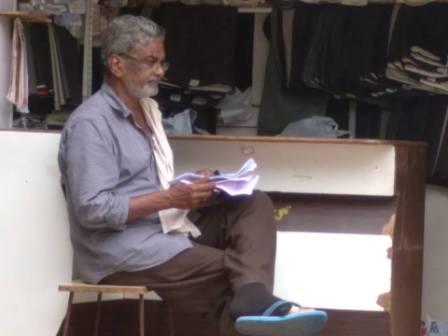Arundhati Roy
[This is her response to Dalit Camera‘s ‘An Open Letter to Ms. Arundhati Roy‘ published yesterday. We wish Ms. Roy could similarly address the issues raised in other articles in Round Table India by Anoop Kumar – here, here and here – and by Akshay Pathak, here]
Dear Friends at Dalit Camera
Thank you for your letter and your straightforward questions on this complicated and vital debate.
I am not aware of what rumours are circulating in Hyderabad or what sources local newspapers there were using to speak about the event. Let me clarify that there was no connection between the cancellation of the EFLU event and the cancellation of the book launch in Hyderabad. And yes, the launch was cancelled by Navayana for a number of reasons, including an SMS that was circulated that said: “Save Ambedkar writings. Oppose Navayan publication. Annihilation of Caste is our holy book. Arundhati Roy and Anand. S contaminated it. Participate in the protest on 9th March at Sundaraiah Vigynana Kendram, Hyderabad.”
I do not know who sent this message around, it could be anybody, even non-Dalit mischief makers, of whom there are plenty, who would certainly want this book out of the way. But since the book was not available and few people had read it, you will agree, given the climate in our country, that it would have been foolhardy to let a situation like this play out. (And while some may want to claim it as a holy book, let me quote Ambedkar from his 1937 preface to the second edition of Annihilation of Caste: “The speech prepared by me for the Jat-Pat-Todak Mandal of Lahore has had an astonishingly warm reception from the Hindu public for whom it was primarily intended.“). Emphasis mine. The mis-translation of The Doctor and the Saint into Telugu in the daily Andhra Jyothi, completely missed the irony in my title, and this is unfortunate. I must add that the ironical reference to Gandhi as a ‘Saint’ comes from Ambedkar’s own sarcasm in what he called his “Reply to the Mahatma” (included in the Navayana edition) in which he calls Gandhi a politician-saint and consistently refers to him as the “Mahatma”.
I wish to clarify for those who are accusing you of trying to ask for a ban on the book that this is not the case. You obviously disagree with it, you dislike my introduction. It’s a debate, a somewhat acrimonious one, but nothing more. About the derogatory adjectives that are being used to describe the debate—what can I say? I cannot be held responsible for what others say. The internet is an insult machine. If it’s any consolation, I’m sure I’d be among the finalists in the race for the most insulted people. We can do nothing more than keep a cool head.
Now let me try and answer some of your other questions.
First of all, on the subject of representation. This is crucial. So much of Ambedkar’s political work, and ironically, a large part of my introduction deals with this. Our debate of course is not about the political representation of Dalits in general, but whether a non-Dalit can/should have written this introduction at all. It is not a new debate, but one that the Civil rights movement in the USA, Feminists all over the world, the anti-Apartheid movement in South Africa, and the Queer Movement deal with all the time. If it is your case that a Dalit would be able to give the world a more accurate description of the lived experience of being Dalit, I agree with you. If it is your case that only Dalits can write an introduction about Ambedkar, then I must disagree with you. What if tomorrow Gujarati banias say only they can write about Gandhi? Or Mahars say that their understanding of Ambedkar is more authentic and more radical than that of other Dalits?
On the issue of caste, unlike in the other debates, the issue of the ‘authentic victim’ is one that is more vexed than ever. Once again, let’s turn to Ambedkar who said ” there is no such class as a completely unprivileged class except the one which is at the base of the social pyramid. The privileges of the rest are graded. Even the low is privileged as compared with the lower. Each class being privileged, every class is interested in maintaining the system.”
If it is your case that a Dalit writing about Ambedkar will have a different reading from a non-Dalit, a privileged caste Hindu, then I agree with you—though I would still exercise caution against essentialism of this sort. But to say that every Dalit reading is automatically ‘authentic’ and every non-Dalit reading is ‘misleading’ is not something that I agree with. The point is, whatever my privileges are—or yours for that matter—are we fighting against Brahminism or strengthening it? If it is your argument that through my introduction I am somehow actually perpetuating caste, please tell me how that is so.
Ambedkar was a man with a phenomenal breadth of scholarship—he wrote about Marxism, Islam, Buddhism, law, the economy, and he was the Chairman of the committee that drafted the Indian Constitution that governs every single Indian citizen. In Annihilation of Caste he indicts several of Hinduism’s sacred texts, he writes about socialism, about Adivasis, about Muslims and Sikhs. Who can police who is allowed to write about him, comment on his texts, or introduce them, and who is not?
In the past I have written about Big Dams, Nuclear bombs, Corporate Globalization and many other things. Each time people have had objections—similar to yours— about the fact that I have written about them, without being a displaced person, or a bomb expert, or an economist.
Have I ‘researched’ Dalit history? Have I been part of Dalit movements? Do I consider myself an authority on Ambedkar? Do I think Dalit scholars are better placed to write an introduction to Annihilation of Caste? How can any non-Dalit be part of a Dalit movement when you will not even concede that they have the right to engage with Ambedkar? On the subject of my engagement with caste, my past work as well as this introduction might contain the answer. I am not a Dalit, I am not a Hindu, and I am not an authority on Ambedkar, though I have, unlike many people, including many Dalits, taken the trouble to read him. I do not write from a position of authority. I write from the position of a writer who engages with things that she feels are important to her, and to the society that she lives in. I am sure there are several scholars, both Dalit and non-Dalit who are better placed to write an introduction to Annihilation of Caste far more knowledgeable than mine. They should go ahead and do so. There is no limit on the number of introductions that can be written. As you know, and as you yourself say, it is a text that has existed for 80 years, it has been circulated, distributed and translated into several languages. Mine is just one more introduction—not the best, not the greatest and certainly not the last—to one more edition. And this edition will not, cannot, despite the space it has received in two mainstream magazines—match the circulation of the others which numbers in the tens of thousands.
As far as I know, the only thing special about the Navayana edition is that it has been extensively annotated. This too has come in for criticism. The fact is that in Annhilation of Caste Ambedkar makes a range of references, to incidents, to philosophical concepts, to scholars and philosophers, and he cites Sanskrit slokas without translating them. The annotations try to explain all of this. How does this constitute a crime?
You say I patronize Ambedkar? I find that offensive. Why would I spend so much time reading what he wrote, and writing this introduction, just in order to patronize him? Here’s what I say: “More than anything else, what Ambedkar brought to a complicated, multifaceted political struggle, with more than its fair share of sectarianism, obscurantism and skullduggery, was intelligence.”
Does this sound patronizing to you? My introduction ends by saying: “Can caste be annihilated? Not unless we show the courage to rearrange the stars in our firmament. Not unless those who call themselves revolutionary develop a radical critique of Brahminism. Not unless those who understand Brahminism sharpen their critique of capitalism. And not unless we read Babasaheb Ambedkar. If not inside our classrooms then outside them. Until then we will remain what he called the “sick men” and women of Hindustan, who seem to have no desire to get well.”
This is patronizing?
Finally, on the question of the amount of space that Gandhi occupies in my introduction. I do know, and was fully aware of the fact that there are sections of Dalit intellectuals who object to Gandhi even being mentioned when we speak of Ambedkar. I disagree. In his preface to the 1937 edition to Annihilation of Caste, Ambedkar says: “Besides Mr Gandhi, many others have already criticized my views as expressed in this speech. But I have felt that in taking notice of such adverse comments, I should limit myself to Mr Gandhi. This I have done, not because what he has said is so weighty, but because to many a Hindu he is an oracle so great that when he opens his lips it is expected that the argument must close and no dog must bark.”
It was Ambedkar’s debate with Gandhi over the Annihilation of Caste and Ambedkar’s own voluminous writings on Gandhi that led me to look at Gandhi in a completely different way from the one we have been brainwashed into. Gandhi thwarted Ambedkar at every step. But who, other than Dalits, knows this? Today, there is a huge project within the establishment and its pet intellectuals, to co-opt Ambedkar into being the junior partner in Gandhi‘s fight against caste. All the anti-caste poets and intellectuals, including those who renounced Hinduism, are being made part of the great Hindu pantheon, and this includes Ambedkar himself.
Ambedkar has written so much on Gandhi and Gandhism—in Gandhism, the Doom of Untouchables, he says “some have so much faith in it that they do not hesitate to offer it as an alternative to Marxism.” Gandhi has by no means gone away. He continues to embody the moral co-ordinates of the Indian nation state. The Indian Government is still going about getting Gandhi statues placed in countries abroad. He is India’s greatest and most unique export. It may be true that Dalits, for the most part, have not been indoctrinated in Gandhism as much as the rest of us have. But all over the world he is a great great hero—even for Africans and African Americans who he had such contempt for. Marxism has taken a huge hit after the fall of the Soviet Union, but Gandhi continues to be thought of as the embodiment of goodness and saintliness. Moving the Gandhi monument out of the way in order for a reader to get to Ambedkar’s writing cannot be done casually, carelessly or in a couple of paragraphs. That would do more harm than good.
Anyway, these are my thoughts. This is my introduction. It may not fit into your notion of what such an introduction should be. But perhaps we have different readerships in mind? I was writing for those in India,and as well as outside, who are new to the subject, for whom caste is just some exotic Hindu thing. (I saw a new line of handbags in a department store in the US called ‘Brahmin.’) I am sorry that you have reacted with such anger to my introduction, because it is written in complete and absolute solidarity with the anti-caste movement, and because I believe that caste corrodes us all.
With best wishes,
~
Please also read other articles on the same issue:
Introducing Arundhati Roy and Friends : Karthik Navayan
A tale of two prefaces: by Karthick RM
Between Savior and Seller: Critiquing Preface Politics: by Praveena Thaali
A Glass Menagerie for the Bahujans—Annihilation of Caste and Gandhi’s Wards: by James Michael and Akshay Pathak
Stigmatizing Dalits, From the Wadas to the Web: by Nilesh Kumar
Without Arundhati Roy and Gandhi, the book had its own value: Bojja Tharakam
Caste in the Name of Christ: An angry note on the Syrian Christian Caste: by Nidhin Shobhana
The Not-So-Intimate Enemy: The Loss and Erasure of the Self Under Casteism: by Gee Imaan Semmalar
Flaunting noble intentions, nurturing caste privileges: by Asha Kowtal
The Question of Free Speech: by Vaibhav Wasnik
An Open Letter to Ms. Arundhati Roy
Vedic Chants for the 21st Century
Arundhati Roy’s ‘Introduction’ to Ambedkar: Inside one Misogynistic & Xenophobic Dalit’s mind: by Anoop Kumar
The Judge, the Jury and the Goddess: by Akshay Pathak
Resisting a messiah: by Anoop Kumar
An Introduction to Anoop Kumar’s “Misogynistic and Xenophobic Rants”: by Vinay Bhat
~~~
Please find Dalit Camera’s FB page here.










